Sunday 27 July 1941
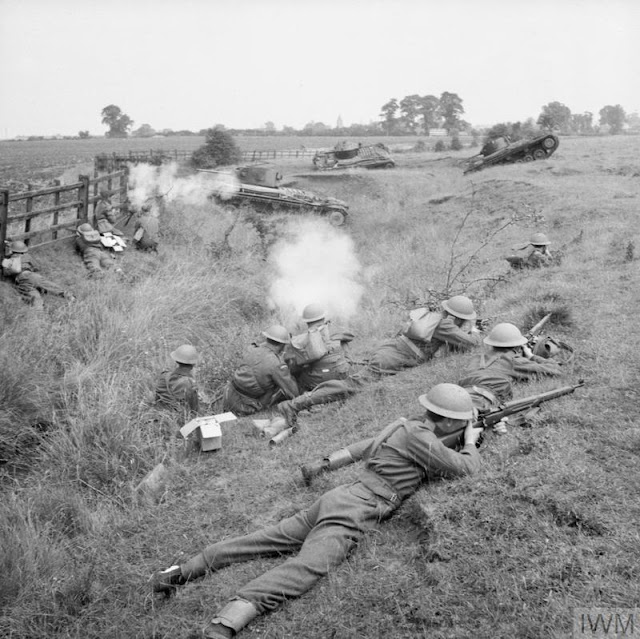 |
| "Home Guard troops 'fighting' Valentine tanks of 6th Armoured Division during large-scale manoeuvres at Yelden in Bedfordshire, 27 July 1941." © IWM (H 12081). |
It is an odd event, made necessary in the eyes of OKW and Hitler due to the strong opposition by many generals and Field Marshals to this strategy. The main targets are Generals Guderian and Hoth, whose Panzer Groups 2 and 3, respectively, have outpaced their colleagues. Both generals disagree, with Guderian writing in his journal that Hitler:
preferred a plan by which small enemy forces were to be encircled and destroyed piecemeal and the enemy thus bled to death. All the officers who took part in the conference were of the opinion that this was incorrect.The importance of the meeting is not so much what is said, but the fact that Hitler and von Brauchitsch feel it is necessary at all. That it is held at the Army Group Center headquarters also is significant, given that von Bock, Hoth, and Guderian are intent on taking Moscow, which they feel is easily within their grasp.
When the meeting is over, Guderian hurriedly puts together a plan with Hoth and von Bock to honor Directive 33 in form, but not in substance. From here on, generals on the eastern front will often operate through "back channels" and conduct their operations with increasingly looser "interpretations" of OKW (and Hitler) orders.
There is something to be said for both the OKW position and that of von Bock, Hoth, and Guderian. On the one hand, the panzers have been fighting steadily for over a month and simply driving for that long puts a heavy strain on the equipment, let alone engaging in endless combat. On the other hand, however, the Red Army is reeling and it is imperative for the Wehrmacht to destroy the Soviet capacity to resist quickly during good campaigning weather.
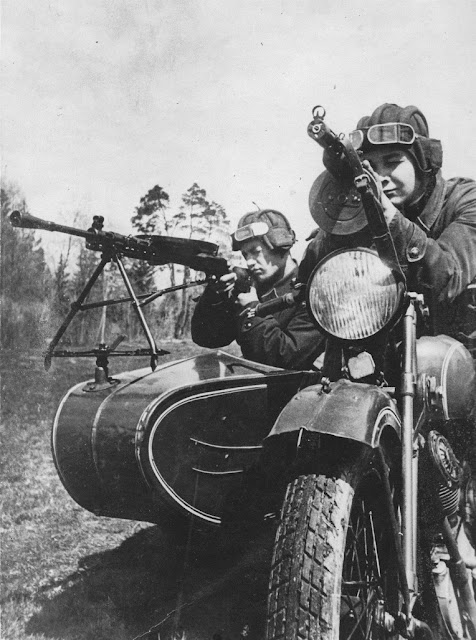 |
| In this July 1941 propaganda shot, Red Army soldiers are on a TIZ AM-600 motorcycle with a mounted DP-27 machine gun. |
In the Army Group North sector, the Germans approach the Estonian capital Tallinn and capture it late in the day. There is heavy fighting near Velikiye Luki.
In the Army Group Center sector, German forces, after many days of trying, finally link up to the east of Smolensk. This happens when XXXIX Korps (General R. Schmidt) of Panzer Group 3 meets XLVII Korps (General J. Lemelsen) of Panzer Group 2. There is little question that at this stage of the war the panzers of Generals Hoth and Guderian have formed a powerful combination that is clearing the way east.
In the Mogilev area, Soviet resistance ends due to a lack of supplies. About 35,000 Soviet troops go into captivity. A small number of trapped soldiers manage to escape to the east.
This closes a massive pocket that traps large portions of Soviet 16th, 19th, and 20th Armies. The Soviets immediately begin planning a breakout, to be led by the 20th Army. The German line is weak because the infantry is still struggling to catch up with the panzers on the eastern side of the pocket.
In the Army Group South sector, Soviet 26th Army counterattacks Panzer Group 1. The panzers are greatly in need of repair and maintenance, as noted in the war diary of LVII Korps (General Kuntzen):
It must be understood that without a rapid and plentiful supply of track rollers, track links and bolts for the Mark IV and track bolts for the Kpfw 38(t) the number of available panzers will sink further so that the combat strength of the panzer regiments will be greatly weakened. Still especially urgent is the delivery of fully operational motors, gearboxes, oil and specialized panzer grease.
This need to pause the offensive is understood at the very highest and the lower levels of the Wehrmacht, but, as noted above, many generals seeking the glory of conquest refuse to accept it.
Romania occupies the final section of territory that it considers rightfully due it according to its previous historical control. Meanwhile, German 17th Army continues pushing to close the trap at Uman.
 |
| The Bf 109E7 "White 12" of Luftwaffe ace Lt. Joachim Müncheberg in Libya, 7,/JG 27, July 1941. |
RAF Bomber Command sends six Blenheim bombers on a raid to the Yainville power station. However, the heavy clouds cause the bombers to turn back without completing their mission. A Circus raid over Le Trait accomplishes little.
Later, the RAF attempts a raid by 14 Wellingtons and Whitleys to Dunkirk. However, these bombers also have to turn back due to the weather. Minor operations by 36 Hampdens laying mines off of Lorient and St. Nazaire, however, are successful. The British lose one bomber.
After dark, the Luftwaffe makes its largest raid on London in 10 weeks, putting 50 aircraft over the capital. The Germans lose four planes.
Battle of the Baltic: The German 3rd Motor Torpedo Boat Flotilla (S-54, S-55, S-57, and S-58) attacks Soviet shipping in the Gulf of Riga. S-54 and S-55 sink 1690-ton Soviet destroyer Smelyi, while S-57 and S-58 attack other ships without success at Oesel. The motor torpedo boats also sink Latvian coaster Lashplesis off Saaremaa, Estonia.
The Red Air Force bombs and sinks 338-ton German trawler Elbing III near Libau.
 |
| HMS Whitehall armed with experimental depth charge throwers in the bows. These are tested on 27 July 1941 (Beadell, SJ (Lt), © IWM (A 4671)). |
U-79 (Kptlt. Wolfgang Kaufmann), on its second patrol out of Lorient, fires four torpedoes at 02:54 and sinks the 2475-ton British freighter Hawkinge. There are 15 deaths. U-79 also claims to sink two other freighters today, but those are usually attributed to other U-boats.
U-203 (Kptlt. Rolf Mützelburg), on its second patrol out of St. Nazaire, torpedos and sinks 2475-ton British freighter Hawkinge. There are 14 deaths.
U-126 (Kptlt. Ernst Bauer), on its first patrol out of Bremen, torpedoes and sinks two ships:
5102-ton British freighter EratoThere are nine deaths on Erato (27 survivors, including the master) and three on Inga I (16 survivors, including the master). U-126 also claims to sink two other ships today, but those are usually allocated to U-79 and U-203.
1304-ton Norwegian freighter Inga I
The Luftwaffe bombs and sinks 198-ton British fishing trawler Ben Strome about fifteen miles southeast of Fuglo Island in the Faroes. Everybody on board, ten men, perishes.
The RAF drops an aerial mine on 1582-ton Danish freighter Knud Vellemoes north of Heligoland, sinking it.
 |
| SS Hawkinge, sunk by U-79 on 27 July 1941. |
Norwegian 4785-ton freighter Lidvard escapes from internment at Dakar into the Atlantic. A chase ensues as Vichy French light cruisers Georges Leygues and Gloire, aircraft, and submarine Acteon attempt to stop Lidvard. However, the Norwegian ship is spotted by Royal Navy destroyer Highlander, which takes it to Freetown.
Royal Navy corvettes HMS Gardenia and Amaranthus intercept 130-ton Vichy French auxiliary patrol ship Edith Germaine off the African coast. However, reflecting the complicated politics involved, the Royal Navy ships allow the Vichy French ship to proceed.
Operation FB, the attack on Kirkenes (in conjunction with Operation EF), proceeds as Force A departs from Scapa Flow bound for Seidisfjord, Norway.
U-371 (Kptlt. Heinrich Driver) spots Convoy OS-1 west of Portugal and shadows it.
Convoy ON-2 departs from Liverpool, Convoy HX-141 departs from Halifax bound for Liverpool.
 |
| "A view of 5 throwers in line. Depth charges can be seen ready, loaded into the muzzle of the thrower. Ratings can be seen preparing the depth charges." The sailors on HMS Whitehall call the experimental Fairlie mortars, which are tested on 27 July 1941, the "Five Wide Virgins." © IWM (A 4664). |
Royal Navy submarine HMS Tetrarch uses its deck gun to sink Italian caique Nicita about five miles south of the Greek island of Kos.
Operation Guillotine, the reinforcement by the Royal Navy of Cyprus, continues as 6676-ton transport Salamalia departs Port Said for Famagusta.
The Luftwaffe attacks the Suez Canal during the night.
An Axis convoy departs from Naples bound for Tripoli. It has a heavy escort which includes the Italian 8th Cruiser Division. A return convoy from Tripoli also puts to sea.
Battle of the Baltic: Soviet passenger ship Lenin hits a mine and sinks within 10 minutes between Sevastopol and Yalta. There are about 643 survivors and 1000+ deaths, including a large fraction of 1200 Soviet soldiers of the Red Army reserves. The best estimates place the total casualties at 2500-4600 people, but there is no passenger list. Apparently, the mine was in a "friendly" minefield in an area that the Lenin should have avoided. Navy pilot Lieutenant I.I. Svistun survives the sinking, but not for long - Svistun is blamed for the blunder. He will be shot for his error on 24 August.
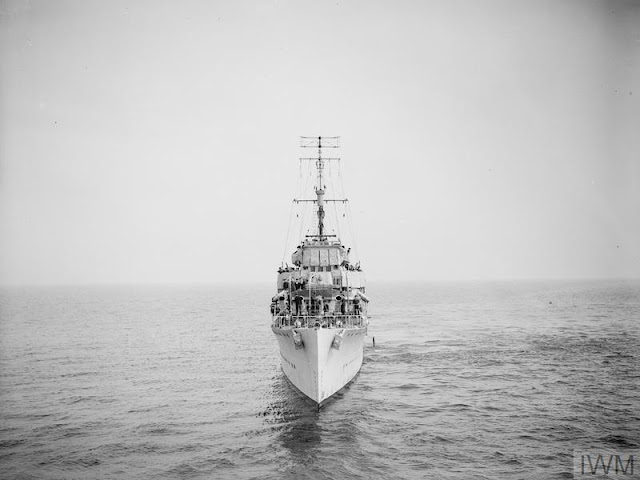 |
| "A bow view of HMS WHITEHALL, showing the depth charge throwers." 27 July 1941 (Beadell, SJ (Lt), © IWM (A 4672)) |
War Crimes: OKW Chief Wilhelm Keitel orders destroyed all copies of the OKW order of 13 May 1941 which provided, among other things, that Wehrmacht soldiers could commit crimes on the eastern front with impunity. The order, issued under Keitel's signature, also provided that civilians suspected of partisan activities could be shot. However, the order itself is not rescinded. In fact, Keitel basically supplemented the 13 +May order on 23 July 1941, when he issued an order stating that legal punishments are inadequate for quelling civil disturbances and the Wehrmacht is free to use whatever means it so chooses to subdue the Soviet population. Copies of the German orders survive in Soviet files and are used against Keitel at the Nuremberg trials.
Partisans: There is an uprising by several hundred Serb men in Srb, Croatia. It is motivated by the killings of local Serbs by Ustasa units led by Vjekoslav Maks Luburic. This is a very controversial incident, and the controversy centers around exactly what the uprising was about and who it was directed against. The official state description is that it was an uprising by local Serbs against the occupying German forces, while some others claim that it was a nationalist uprising by ethnic Serbs directed against Croat civilians.
It is not possible to say what damage was inflicted on the British Navy but knowing how our seamen delivered the attack one must rest assured that at least eight more British units have been rendered unseaworthy. With this exploit which may be compared with the greatest naval battles was concluded a three-day epic, opened on 23 July by the action of one of our submarines and so successfully carried out by our aviation and MAs.Of course, the Italian attackers didn't disable any Royal Navy ships at all and only managed to destroy an old stone bridge.
US/Japanese Relations: The Japanese lodge a diplomatic protest with the United States over the delivery of war supplies to the Soviet port of Vladivostok. This technically violates neutrality laws, but the US at this point isn't too worried about those.
German/Spanish Relations: The Spanish add to their volunteer Blue Division on the eastern front by sending a small volunteer air group. The Escuadra Azul joins III,/JG 27 to become 15,/JG 27 of General Kesselring's Luftlotte 2. Captain Angel Salas Larrazabal leads the unit, which is equipped with Bf 109E fighters.
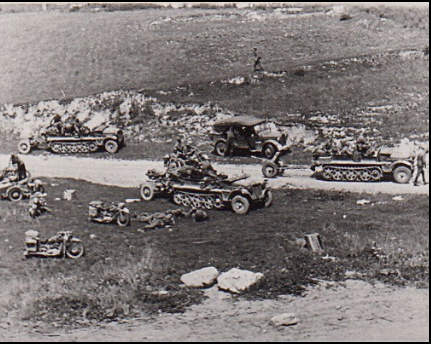 |
| German motorized AT troops near Cholm, 27 July 1941. |
Ecuadorian/Peruvian War: While a cease-fire is being negotiated, it has not yet taken effect. The Peruvian military has a paratrooper unit which it uses today to seize the port city of Puerto Bolivar. This is the first time in the Americas (and one of the very few times ever) that airborne troops are used to successfully seize a strategic objective from enemy control.
Soviet Military: The NKVD executes the son and nephews, four teens in total, of Lavrentiy Beria's old nemesis Nestor Lakoba in Moscow. In addition, the State Defense Committee condemns to death nine more Soviet officers whose crime is failing to stop the Germans.
 |
| General Douglas MacArthur. |
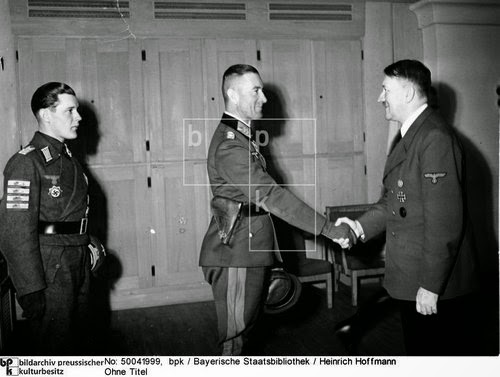 |
| General Lemelsen receives the Knight's Cross at the hand of Adolf Hitler on or about 27 July 1941 (Heinrich Hoffmann). |
General der Panzertruppe Joachim Hermann August Lemelsen receives the Knights Cross today for his performance in command of the 47 Panzerkorps at Smolensk.
Luftwaffe ace (27 victories) Hans Kolbow, KIA 17 July 1941 south of Stara Bychow by Soviet flak, is posthumously awarded the Ritterkreuz.
Japanese Government: Japan Finance Minister Masatsune Ogura announces that the proper plan for Japan is to "forge ahead towards the establishment of the Greater East Asia Co-prosperity sphere." The Imperial General Headquarters is reaching the same conclusion and making plans to strike to the south, not north toward the Soviet Union in order to help its ally Germany.
 |
| A Peruvian Navy Almirante Grau class cruiser in Ecuadorian waters during the Peruvian/Ecuadorian conflict, July 1941. |
German Government: During his evening rambles with cronies, Hitler gives his vision of a successful campaign in the USSR:
We must take care to prevent a military power from ever again establishing itself on this side of the Urals, for our neighbors to the West would always be allied with our neighbors to the East. That's how the French once made common cause with the Turks, and now the English are behaving in the same fashion with the Soviets. When I say, on this side of the Urals, I mean a line running two or three hundred kilometers east of the Urals.Heretofore, there has been virtually no discussion within the German government as to what a successful conclusion to Operation Barbarossa would look like. At least now Hitler indicates that the limit of the Wehrmacht's advance would be slightly beyond the Ural mountain range. Presumably, a decapitated Soviet state would remain on the far side of the Urals, with the Wehrmacht watching it sort of like Roman soldiers manning the Danube.
Iceland: Advance units of the US 45th Infantry Division arrive at Reykjavik. US transport American Legion sets sail for Iceland from Norfolk, Virginia carrying part of the USAAF 33rd Pursuit Squadron. Its planes travel aboard the aircraft carrier USS Wasp (CV-7). US Task Force TF.16, led by battleship Mississippi, escorts the Wasp to the north.
 |
| Jews at Kovno, Lithuania being assembled before being led to the Seventh Fort to be executed by the Lithuanian militia, 27 July 1941 (Yad Vashem Photo Archives 76BO2). |
Germans in Belgrade take 1200 Jews from Belgrade to the Tasmajdan concentration camp, where about 120 are shot.
Clothing taken from Jews in Ponas, Ukraine is sold.
Dutch Homefront: The Freiwillingen Legion Niederlander (Dutch Volunteer Legion), an auxiliary force for the SS, is established under the command of Lieutenant-General Henry Alexander Seyffardt.
American Homefront: David Ross Brower becomes the first to climb the Lost Brother peak in the Sierra Nevada, one of 33 peaks in the mountain range that he is the first to ascend. This apparently is Brower's last "first" in the range. He later recounts his experiences in "A Climber's Guide to the High Sierra" (Sierra Club, 1954). Brower will serve as a lieutenant in the US 10th Mountain Division and earn a Bronze Star in action in Italy.
Future History: Andrew McMaster is born in Carlton, Glasgow, Scotland. He becomes a very successful songwriter during the 1970s, writing or co-writing hits for the UK charts such as "Airport," "Forget About You," and "Dancing the Night Away." Andy McMaster continues to release material as of 2018.
 |
| The German forces arriving in Mogilev tell the Jewish women that they have to 'register' with the authorities. On or about 28 July 1941 (Kessler, Rudolf, Federal Archive). |
July 1941
July 1, 1941: US TV Broadcasting Starts
July 2, 1941: MAUD Report
July 3, 1941: Stalin Speaks
July 4, 1941: Pogroms in Eastern Europe
July 5, 1941: Germans on Schedule
July 6, 1941: Australians Attack Damour
July 7, 1941: US Marines in Iceland
July 8, 1941: Flying Fortresses In Action
July 9, 1941: British Take Damour
July 10, 1941: Sword and Scabbard Order
July 11, 1941: Cease-fire in Syria and Lebanon
July 12, 1941: Anglo/Russian Assistance Pact
July 13, 1941: Uprising in Montenegro
July 14, 1941: Katyusha Rocket Launchers in Action
July 15, 1941: Smolensk Falls
July 16, 1941: Stalin's Son Captured
July 17, 1941: Heydrich Orders Mass Executions
July 18, 1941: Twin Pimples Raid
July 19, 1941: V for Victory
July 20, 1941: The Man Who Wouldn't Shoot
July 21, 1941: Moscow in Flames
July 22, 1941: Soviet Generals Executed
July 23, 1941: Secret Plan JB 355
July 24, 1941: Operation Sunrise
July 25, 1941: US Naval Alert
July 26, 1941: Italian E-Boat Attack on Malta
July 27, 1941: MacArthur Returns
July 28, 1941: Auschwitz Exterminations
July 29, 1941: Rescue From Crete
July 30, 1941: Raid on Petsamo and Kirkenes
July 31, 1941: Final Solution Order
2020
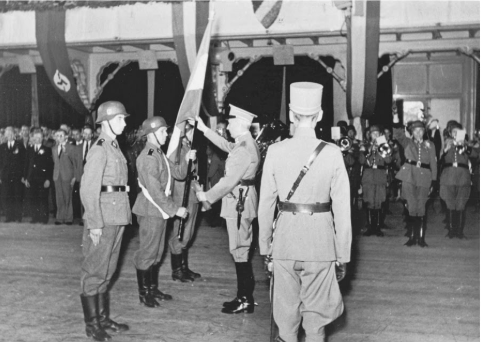
No comments:
Post a Comment